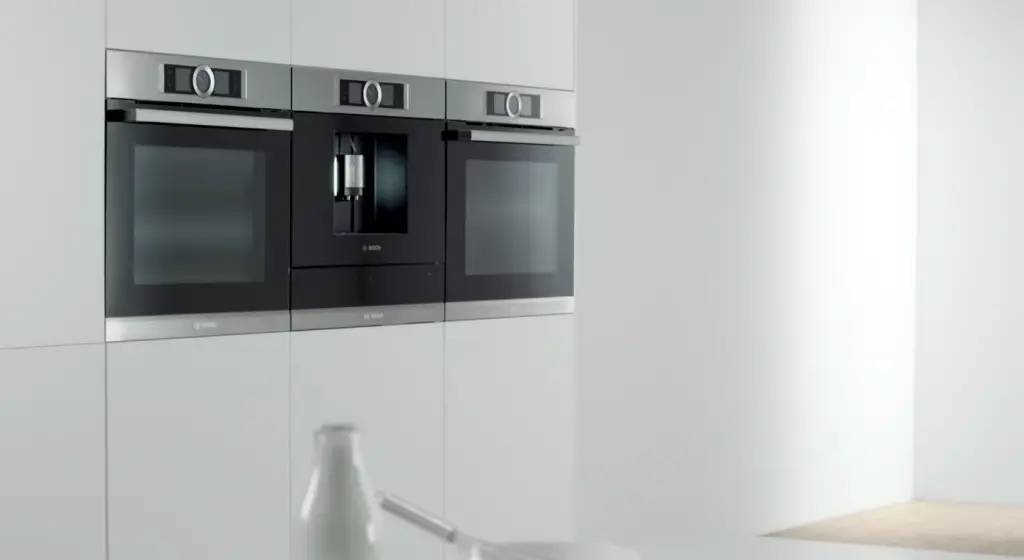What you find on this page:
It can be frustrating if you own a Bosch oven and are experiencing operational problems during use. This helpful guide will cover many common Bosch oven temperature problems, from temperature fluctuations to error codes and power issues.
So, we have the answers for you if you have questions about Bosch oven accessories or need to pinpoint which part is causing a problem.
Bosch Oven Temperature: Problems and Solutions
You don’t have to be a technician to handle several problems that may occur with your Bosch oven and range. With a little bit of research and some simple solutions, you can have your oven operating again at the correct temperature. This way, you won’t be spending a ton of money on a professional to perform repairs or running out and purchasing a replacement model.
Let’s look at some of these typical issues with a Bosch oven not heating correctly.
The Oven Is In ‘Demo’ Mode
Sometimes when you bring home a new appliance from the store, it will be in Demo mode. This feature allows potential customers to browse all the settings and options without fully operating the oven.
Another reason why your Bosch oven is displaying Demo mode could be that it was accidentally activated at home when exploring the settings. Thankfully, it is a simple process to return it to regular operation.
First, disconnect the power supply or turn off the circuit breaker for a few minutes. Next, plug it back in or turn on the power breaker. Finally, you must turn off Demo mode in the settings panel within three minutes of restoring power.
- Choose Settings on the display panel.
- Manually scroll through the available options until you find Demo Mode.
- Highlight the ON selection and change it to OFF.
- Hit Enter to save changes, and it should operate normally.
One vital consideration is that the oven must be connected to a 208/240V power source to allow Demo mode to be deactivated entirely. If you are not using an adequate power source, your Bosch oven will remain in Demo mode. Avoid using extension cords to connect your oven as many of them cannot accommodate this higher voltage.

The Circuit Breaker Has Low Electrical Power
A Bosch oven won’t heat up if it’s connected to a power source that is too low for proper functionality. You may also receive a Bosch oven error code E305, stating there is no connection to the base plates.
To be sure that your electrical panel can handle your new Bosch oven, you need to check the amperage on your home breaker and compare it to the amperage your oven model requires. Sometimes an electrician can help you determine if this is the root cause of your oven not heating up.
A professional electrician should complete this job if your home requires a new breaker. This way, you don’t risk harm to yourself or damage to your appliance. Replacing a breaker without the proper tools or knowledge can be disastrous for the appliances in your home.
A Heating Element Is Damaged
If you have Bosch oven temperature problems, it could be the heating element. If it doesn’t glow red or orange when in use or has visible signs of wear and tear, it’s quite possible the heating element is damaged and needs replacement.
If your oven is still under warranty, you may be required to have a Bosch repair specialist come in to complete this task. Alternatively, if the warranty has lapsed and you are comfortable with some DIY home repairs, replacing a heating element yourself is easy and cost-effective.
- Disconnect the power to the oven.
- Remove the back panel of the oven to access the heating element connections.
- Make a note of where the connection wires are and remove them.
- Unscrew the heating element from the oven at the back and front and remove it.
- Replace with a new heating element and fasten the screws to secure it back into place.
- Reattach the connection wires to the oven.
- Replace the back cover for the oven.
- Reinstate the power to the oven, and it should heat up fine.
The Oven Igniter Is Damaged
If you have a Bosch gas oven, it will require both natural gas and electricity to function completely. Therefore, a damaged igniter will prevent the oven from heating up, as it should since it needs to build up enough heat for proper operation.
Sometimes homeowners can override the oven igniter by manually lighting their oven’s pilot light with a match. However, if the pilot light is active and your Bosch oven won’t turn on and heat up, you could need a new igniter.
You can easily replace your oven igniter at home by taking it out and swapping it with a new one from your local Bosch parts dealer. You will need to wear gloves during this process to avoid touching the connections with bare hands and transferring skin oils that could damage these parts.
- The oven igniter is located under the bottom plate of the range.
- Remove all wire racks and unscrew the bottom plate to expose the igniter.
- Unscrew the harness that holds the igniter and unplug it from its harness.
- Replace with a new igniter, connect it to the harness, and secure it into place.
- Replace the bottom cover and wire racks in the oven.
The Temperature Sensor Is Defective
If an oven’s temperature sensor is defective, it cannot tell the control panel to heat the oven to the desired level. Therefore, you may require a Bosch electric oven overheating repair to rectify this problem.
Like the oven igniter, if you are handy around the house, you can replace the temperature sensor on your own.
- Disconnect the power to the oven.
- Remove the back panel to access the temperature sensor.
- Locate the wiring harness in the upper right section and press the built-in tabs to release the sensor.
- Unscrew the temperature sensor from the oven and replace it with a new one.
- Screw the new sensor into its place, and connect the wires to the harness.
- Replace the back panel and restore power to the oven.
Baking Ignitor Removal
If you want to replace the ignitor yourself, it is possible. However, ensure that your Bosch oven is no longer under warranty, as tampering with an appliance during this time can void it altogether.
- Disconnect the power and natural gas to the oven.
- Unscrew the back panel to access the oven igniter.
- Remove the igniter wire from its harness.
- Remove the oven door and racks to access the bottom panel.
- Unscrew and take off the bottom panel to find the igniter by the burner.
- Remove the igniter, replace it with a new one, and direct the wires to the back.
- Replace the bottom panel and oven door.
- Attach the igniter wires to its harness and replace the back panel.
- Reintroduce power and natural gas to the oven for operation.

Ignition Removal
Over time, stovetop igniters will crack, break, or malfunction, requiring replacement. Thankfully, this job is easy to tackle if you are handy with a screwdriver.
Before removing an ignition, it’s critical that you turn off the power and natural gas that goes into the oven. You do not want to risk electrocution or filling the house with harmful gas. If possible, open any doors and windows to allow fresh air to circulate through the kitchen during this repair.
- After turning off the power and gas, find the igniter that needs replacing.
- Remove the replacement grates for your Bosch gas stove and set them aside.
- Disconnect the spark igniter from the connecting wire in the stovetop.
- Gently tug on the connecting pipe that attaches to the gas burner.
- Then, turn it over and unscrew the defective ignition to remove it.
- Replace it with a new ignition and secure it into place.
- Return the gas pipe and burner to the stovetop and push it back into place.
- Reconnect the wires from the new ignition to the stovetop.
Removing Oven Door
If you need to remove the oven door to access the inside for further repairs, it’s easy to do.
- Disconnect the power to the oven.
- Open the oven door entirely so you can view the hinges.
- Flip the latches that secure the door hinges to the oven towards you.
- Carefully close the oven door.
- Securely lift the oven door up and out of its hinge slots.
The oven door is heavy, and you will need a firm grip when removing and replacing it. Remember to flip the hinge latches away from you when securing the door back onto the front of the oven before closing the door.
Conclusion
You can quickly rectify many Bosch double wall oven problems with some simple troubleshooting and minor adjustments or repairs. If you are comfortable performing these tasks on your oven at home, you can save time and money instead of calling a repair person.
Be sure to check your warranty documentation before beginning any repair to ensure that completing repairs on your own won’t void your existing warranty.
FAQs
If you have any other Bosch electric range problems, these frequently asked questions might help solve your problems.
Calibrating the temperature for a Bosch oven will vary depending on the model you have. Some models will have the calibration built into the manual turn dial, while others require using an oven-safe temperature probe and monitoring the fluctuations over time. Then, you would manually adjust the temperature offsets through the Settings menu.
When an oven runs, it will cycle to reach the desired temperature. Then it scales back to avoid going over. This continuous cycling of up and down will vary slightly, but it should typically stay within a small 15-degree range.
If an oven has extreme temperature changes during this cycling of too high or too low, it could mean the thermostat is broken or defective.
If your food is consistently overcooked or undercooked, you may need a Bosch oven thermostat replacement. Another sign the thermostat requires replacing is when you use a multimeter to measure its temperature. Therefore, if it reads at 0, or as low as possible, close to 0, replacing the thermostat is necessary.
Depending on your Bosch oven model, the calibration may differ slightly. However, with a digital oven, you will use the Clock/Tools button to scroll through the options until you find Calibrate.
Next, you can choose the upper or lower oven with a double model and follow the prompts to select increase or decrease by 10-degree increments for recalibration. When you are at your desired temperature, press the Start button to save your changes.
You can check your Bosch oven temperature calibration by placing a small thermometer inside the oven and setting the oven to 350 degrees. When the oven reaches the desired temperature, check the thermometer display.
Your oven is correctly calibrated if it’s within a 15-degree range of 350. However, if you find your Bosch oven overheating and the thermometer is over 365 degrees when set at 350, it will need recalibration.
More related content
Amana Self-Cleaning Oven Troubleshooting: All You Need To Know





